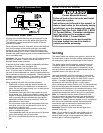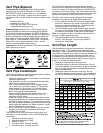
6
Condensate Drain Line
All parts of the condensate trap are glued except for the
1/2” CPVC drain stem joint at the elbow (see figure 3A).
This assembly can be turned with the outlet of the tee
oriented as needed.
Once orientation direction is decided, remove the unglued
joint from the elbow at the bottom and apply a suitable
cement to joint. Re-insert the joint fully and quickly into
the elbow making sure to orient it before the cement sets.
Connect the remaining piping and run the condensate drain
line to a suitable drain.
Important: Be sure the drain stem joint is inserted against
the stop in the elbow. Failure to do so may result in
improper water heater operation.
If required by local codes, install a condensate neutralizer
cartridge on the drain line (see figure 3B).
The condensate drain line must be routed to a suitable
drain. If no floor drain is available or the drain is above
the level of the condensate line, install a condensate pump
that is resistant to the acidic condensate. These pumps are
available from local distributors. If the pump is not resistant
to acidic water, a condensate neutralizer must be used
ahead of the pump.
When installing the drain line, note the following:
• Plastic pipe or tubing must be used to connect the
condensate drain to a suitable drain or condensate
pump. Do not use copper tubing, iron, or steel pipe for
the condensate drain line.
• Condensate drain lines should be installed in condi-
tioned areas only. Drain lines installed in areas that are
subject to freezing temperatures should be wrapped
with a nationally recognized/listed heat tape and/or
approved insulation for freeze protection. Install per
manufacturer’s instructions.
• Do not common drain with the temperature and pres-
sure relief valve or the condensate line from an air
conditioner evaporator coil.
• Slope the condensate drain toward the inside floor
drain or condensate pump.
• The condensate drain line and connection to the drain
piping must comply with all local codes.
• Do not run the condensate line into the metal drain
pan.
VENT PIPE SYSTEM
Carbon Monoxide Hazard
Follow all instructions to locate and install
the vent pipe system.
Instructions can be found in this manual, in
state or local codes (or the authority having
jurisdiction), or in the absence of such, the
National Fuel Gas Code, ANSI Z223.1, NFPA
54, Current Edition. Canadian installations
must be performed in accordance with
CAN/CSA-B149.1, Current Edition.
Failure to properly locate and install the
vent pipe system can result in death or
carbon monoxide poisoning.
Venting
This water heater has a direct vent system in which all air
for combustion is taken from the outside atmosphere and
all combustion products are discharged to the outdoors.
This water heater must be properly vented for removal
of exhaust gases to the outside atmosphere. Correct
installation of the vent pipe system is mandatory for the
safe and efficient operation of this water heater and is an
important factor in the life of the unit.
Vent pipe installation must be performed in accordance
with state and local codes, or in the absence of such, the
National Fuel Gas Code, NFPA 54, ANSI Z223.1-current
edition. Canadian installations must be performed in
accordance with CAN/CSA-B149.1-current edition.
When replacing an existing Polaris
®
unit, it is recommended
that the venting system be reviewed for compliance with
the requirements contained in this installation manual. If the
venting is not in compliance, it is recommended that the
appropriate changes be made to bring it into compliance.
Note: It is important that the factory-installed air inlet
filter be inspected at least twice each year and cleaned if
necessary. See “Integrated Filter Installation, Preventive
Maintenance”. Note: if the vent system is not in compliance
with the current installation manual, the manufacturer
reserves the right to evaluate the installation prior to
granting any warranty on service claims.
Important: Check to make sure the vent pipe is not
blocked in any way.
Note: Do not common vent this water heater with any
other appliance. Do not install in the same chase or
chimney with a metal or high-temperature plastic from
another gas or fuel burning appliance.
Figure 3B: Condensate Drain


















